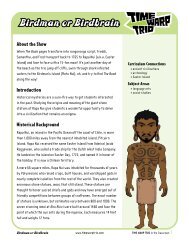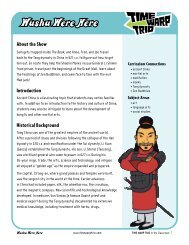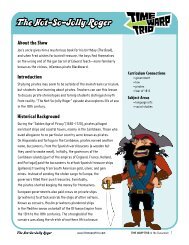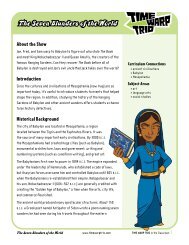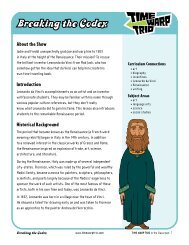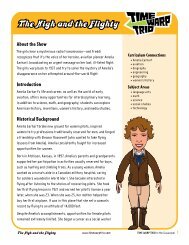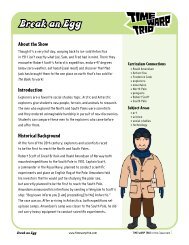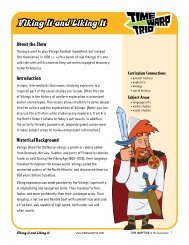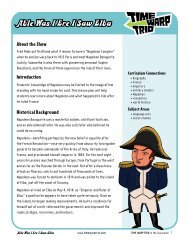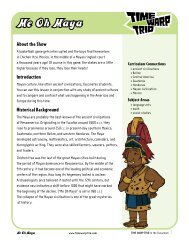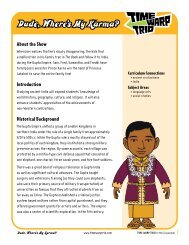You also want an ePaper? Increase the reach of your titles
YUMPU automatically turns print PDFs into web optimized ePapers that Google loves.
2105<br />
2105<br />
About the Show<br />
A class trip to the Natural History Museum ends up zapping the<br />
guys 100 years into the future. <strong>The</strong> <strong>Trio</strong> run into ray-gun toting<br />
robots and meet three mysterious girls who turn out to be their<br />
own great-granddaughters!<br />
Introduction<br />
Envisioning the future is a great way for students to stretch their<br />
imagination, practice descriptive writing techniques, and explore<br />
the genre of science fiction.<br />
Historical Background<br />
Discussing fiction genres can help students identify the elements<br />
that make a particular type of writing unique. Since “2105” is set in<br />
the future, the show and the book (called 2095) offer an opportunity<br />
to discover or learn more about the genre of science fiction.<br />
Science fiction usually features a plot that is based on speculative<br />
scientific discoveries, environmental changes, or life on other<br />
planets. Science fiction can also serve as a commentary on current<br />
social and economic conditions.<br />
A subgenre of science fiction is futuristic science<br />
fiction. Exploring the possibilities of the future<br />
continues to be a popular topic and often ignites<br />
students’ creativity as they consider what<br />
technologies and changes may yet develop.<br />
Many classic science fiction stories, such as the<br />
works of Jules Verne, describe inventions or new<br />
technologies that later become reality.<br />
Utopia, from Sir Thomas More’s book of the same<br />
name (first translated into English in 1551), is the<br />
www.timewarptrio.com<br />
Curriculum Connections<br />
• science fiction<br />
Subject Areas<br />
• language arts<br />
• science<br />
• social studies<br />
<strong>Time</strong> <strong>Warp</strong> <strong>Trio</strong> In the Classroom
2105<br />
2105<br />
Historical Background continued<br />
name commonly given to any society (fictional or experimental) in which economic and social<br />
conditions are ideal. <strong>The</strong> world Sam, Fred, and Joe discover in “2105” has some utopian characteristics<br />
(for instance, kids don’t spend a lot of time on homework), but it also contains some negative, or<br />
dystopian aspects (there is no escaping “sellbots,” which aggressively market products). Futuristic<br />
science fiction is often dystopian, describing society as overly commercialized, technology-dependent,<br />
polluted, and totalitarian. Aldous Huxley’s Brave New World and George Orwell’s 1984 are two of the<br />
best-known novels that describe societies in which technology has become oppressive and deadly.<br />
Fahrenheit 451 by Ray Bradbury also presents a world in which creativity and individuality have been<br />
eliminated. <strong>The</strong> popular novels for young people A Wrinkle in <strong>Time</strong> by Madeleine L’Engle and <strong>The</strong> Giver<br />
by Lois Lowry explore similar themes.<br />
Want students to get even more<br />
excited about history?<br />
www.timewarptrio.com<br />
Check out the adventure about the future at<br />
www.timewarptrio.com/adventures/ 05/<br />
Wordsplosion and other interactive games to play.<br />
Plentifax 487—the ultimate time traveler’s guide—to find out what the<br />
<strong>Time</strong> <strong>Warp</strong> <strong>Trio</strong> see in the future!<br />
Cool Books that kids will love.<br />
<strong>Time</strong> <strong>Warp</strong> <strong>Trio</strong> In the Classroom
Activity<br />
Back to the <strong>Future</strong><br />
in both the book 2095 by Jon Scieszka and the show “2105”<br />
(based on the book), the author describes his vision of the<br />
future. Students can use this description to imagine their<br />
own idea of what the future might be.<br />
Instructions<br />
2105<br />
1<br />
. Distribute the “Excerpt from 2095 “and ask for volunteers to read<br />
it aloud. Discuss with the class how Scieszka has imagined the future.<br />
How likely are the technological innovations he describes? What has<br />
changed in society? What has remained the same?<br />
. Tell students now it’s their turn to imagine the future. <strong>The</strong>y can work<br />
in groups, in pairs, or individually. First they need to decide if they<br />
are going to write a description, draw a picture, write a song, or<br />
present their vision in some other way. If students are working in<br />
groups or pairs they will need to split up the tasks.<br />
. Ask students who are writing a description to compose a one-page<br />
narrative. It can be a letter, diary entry, or prose. It can be narrated<br />
by a time traveler from today or by someone living in the future.<br />
4. Students who are drawing their description should provide as much<br />
detail as possible. Have them label their drawing or write a caption to<br />
go with it. Students working in groups can create a mural with more<br />
than one scene.<br />
5. Have students present their work to the class. Allow time for<br />
student feedback. Give students an opportunity to revise or add to<br />
their project.<br />
www.timewarptrio.com<br />
Objectives<br />
• to make inferences from written<br />
materials<br />
• to write creatively<br />
• to practice descriptive writing<br />
Materials<br />
• “Excerpt from 2095” handout<br />
• butcher and/or construction<br />
paper<br />
• art and writing supplies<br />
Curriculum Standards<br />
• NCSS<br />
<strong>Time</strong>, Continuity, and Change:<br />
Students will develop critical<br />
sensitivities such as empathy<br />
and skepticism regarding<br />
attitudes, values, and behaviors<br />
of people in different historical<br />
contexts.<br />
• NCTe/ira<br />
Students use a variety of<br />
technological and informational<br />
resources (e.g., libraries,<br />
databases, computer networks,<br />
video) to gather and synthesize<br />
information and to create and<br />
communicate knowledge.<br />
<strong>Time</strong> <strong>Warp</strong> <strong>Trio</strong> In the Classroom
2105 www.timewarptrio.com<br />
EXCERPT from 095<br />
by Jon Scieszka<br />
We dodged the first bunch of teenagers. <strong>The</strong>y had corkscrew, spike, and Mohawk hair<br />
in every color you can think of. But the most amazing thing was that no one was touching<br />
the ground.<br />
“<strong>The</strong>y’re flying. People in the future have figured out how to fly,” said Sam.<br />
A solid river of people flowed past us. An old man in an aluminum suit. A woman<br />
with leopard-patterned skin. A class in shiny school uniforms. Everyone was floating<br />
a foot above the floor.<br />
“How do they do that?” I said.<br />
“Look closely,” said Sam. “Everyone has a small disk with a green triangle and a red square.”<br />
<strong>The</strong> sidewalk was full of floating people of every shape and color. <strong>The</strong>re were people<br />
with green skin, blue skin, purple skin, orange, striped, plaid, dotted, and you-name-it skin.<br />
<strong>The</strong> street was packed three high and three deep with floating bullet-shaped things that<br />
must have been anti-gravity cars. And all around the trees of Central Park, towering<br />
buildings spread up and out like gigantic mechanical trees taller than clouds. Layers and<br />
layers of anti-gravity cars and lines of people snaked around a hundred stories above us.<br />
New York was bigger, busier, and noisier than ever.<br />
Source: 2095 by Jon Scieszka. Illustrated by Lane Smith. (Puffin, 1995)<br />
<strong>Time</strong> <strong>Warp</strong> <strong>Trio</strong> In the Classroom<br />
© 2005 WGBH Educational Foundation.
Activity 2<br />
<strong>The</strong> Museum of the <strong>Future</strong><br />
Instructions<br />
. Have students select and read a science fiction book or short story.<br />
You may want to work with the librarian to provide a list of suggested<br />
titles (see Resources). You may also want to extend the scope of<br />
the list to include fantasy stories.<br />
. Once they finish reading the novel, have students read aloud a short<br />
excerpt that describes the future society or land. Discuss the author’s<br />
vision of the future. Ask students whether or not they think it could<br />
come true.<br />
. Have each student create a museum exhibit based on the world their<br />
book describes. Students can manufacture an artifact, an article of<br />
clothing, an animal or other creature from that world; draw or paint<br />
a picture; make a sculpture; write and display a diary entry (or other<br />
written piece); create a diorama; or write and perform a short script.<br />
4. Have students write captions for their exhibit. Take a “tour” of the<br />
museum and have each student introduce his or her exhibit.<br />
2105<br />
www.timewarptrio.com<br />
Objectives<br />
• to use creativity<br />
• to practice oral presentation<br />
skills<br />
Materials<br />
• art and writing supplies<br />
Curriculum Standards<br />
• NCSS<br />
Science, Technology, & Society:<br />
Students should have<br />
experiences that provide<br />
for the study of relationships<br />
among science, technology,<br />
and society.<br />
• NCTe/ira<br />
Students read a wide range<br />
of literature from many<br />
periods, in many genres to<br />
build an understanding of the<br />
many dimensions of human<br />
experience.<br />
<strong>Time</strong> <strong>Warp</strong> <strong>Trio</strong> In the Classroom 5
Resources<br />
Recommended Books<br />
For Teachers<br />
Borderlands of Science<br />
by Charles Sheffield. (Baen, 2000)<br />
This book examines how present-day<br />
science, from astronomy to physics,<br />
inspires our thoughts of the future.<br />
Science Fiction 101: Where to Start<br />
reading and Writing Science Fiction<br />
by Robert Silverberg. (I Books, 2001)<br />
An introduction to the craft and<br />
art of science fiction, including 13<br />
classic stories.<br />
For Students<br />
Fiction<br />
2095 by Jon Scieszka. Illustrated by<br />
Lane Smith. (Puffin, 1995)<br />
<strong>The</strong> <strong>Trio</strong> are zapped into the 21st<br />
century and meet their great-grandkids.<br />
around the World in eighty Days<br />
and 20,000 Leagues Under the Sea<br />
by Jules Verne. (Various editions)<br />
Many of Verne’s visionary concepts,<br />
written in the 19th century, have<br />
come true.<br />
<strong>The</strong> Giver by Lois Lowry. (Houghton<br />
Mifflin, 1993) Jonas’s community seems<br />
to have solved all of society’s problems,<br />
but Jonas begins to understand what<br />
is missing.<br />
my Son, the <strong>Time</strong> Traveler by Dan<br />
Greenburg. (Grosset & Dunlap, 1997)<br />
<strong>The</strong> Zack File series. Zack meets his own<br />
son who has traveled from the future.<br />
See also Trapped in the Museum of<br />
Unnatural History by the same author.<br />
2105<br />
<strong>The</strong> <strong>Time</strong> Bike by Jane Langton.<br />
(HarperCollins, 2000)<br />
Eddie Hall receives an old-fashioned<br />
bicycle from his uncle that enables him<br />
to travel through time. One of six books<br />
about the unusual Hall family.<br />
<strong>Time</strong> Cat: <strong>The</strong> remarkable Journeys of<br />
Jason and Gareth by Lloyd Alexander.<br />
(Holt, 2003) Not only can Gareth the<br />
cat talk, he can take Jason to any place<br />
and time!<br />
<strong>The</strong> <strong>Time</strong> machine by H. G. Wells.<br />
(Various editions) <strong>The</strong> classic novel<br />
of time travel to the future.<br />
a Wrinkle in <strong>Time</strong> by Madeleine L’Engle.<br />
(Farrar, 1990) Meg, her brother Charles<br />
Wallace, and their friend Calvin travel<br />
through space and time in search of the<br />
scientist father of Meg and Charles.<br />
Nonfiction<br />
<strong>The</strong> museum of Hoaxes by Alex Boese.<br />
(Dutton, 2002) Many legends, pranks,<br />
and cons were included in legitimate<br />
collections before they were revealed<br />
to be false.<br />
remarkable Journeys: <strong>The</strong> Story of<br />
Jules Verne by William Schoell.<br />
(Morgan Reynolds, 2002) A biography of<br />
the writer whose stories feature<br />
inventions and technologies that are<br />
now reality.<br />
Science Fiction pioneer: a Story<br />
about Jules Verne<br />
by Tom Streissguth. (Carolrhoda, 2001)<br />
Jules Verne grew up to write about<br />
unusual ways to see the world.<br />
<strong>The</strong> Smithsonian institution<br />
by May Collins. (Grolier, 1999)<br />
Words and photographs describe the<br />
vast array of items in one of the world’s<br />
most incredible museums.<br />
www.timewarptrio.com<br />
Web Sites<br />
iS SCieNCe FiCTioN SCieNCe?<br />
www.pbs.org/kcet/closertotruth/<br />
explore/show_01.html<br />
Michael Crichton, David Brin, and Octavia<br />
Butler debate the merits of science<br />
fiction. Based on the PBS television<br />
series Closer to the Truth.<br />
ray BraDBUry oNLiNe<br />
www.spaceagecity.com/bradbury/<br />
quotes.htm<br />
Visit this site to learn about science<br />
fiction author Ray Bradbury.<br />
reaLiTy UpDaTe: THe Top TeN Dream<br />
iNVeNTioNS oF THe FUTUre<br />
http://inventors.about.com/library/<br />
weekly/aa011599.htm<br />
This list by Mary Bellis updates the<br />
progress being made on inventions such<br />
as an energy stick, a transporter,<br />
a replicator, holograms, and more.<br />
<strong>Time</strong> TraVeL<br />
www.pbs.org/wgbh/nova/time/<br />
This companion Web site to the NOVA<br />
program “<strong>Time</strong> Travel” explores whether<br />
such travel is scientifically possible.<br />
<strong>Time</strong> <strong>Warp</strong> <strong>Trio</strong><br />
www.timewarptrio.com<br />
This site for kids includes interactive<br />
games, fascinating facts, and booklists<br />
that help make the past come alive.<br />
WaNDS aND WorLDS<br />
www.wandsandworlds.com/<br />
Fantasy and science fiction booklists<br />
for children and teens, organized by<br />
categories.<br />
please note:<br />
Although these sites were verified at the time<br />
of publication, Web site addresses and content<br />
are frequently subject to change.<br />
©2005 WGBH Educational Foundation. All rights reserved. <strong>Time</strong> <strong>Warp</strong> <strong>Trio</strong> is produced by WGBH in association with Soup2Nuts for Discovery Kids.<br />
Major funding was provided by a grant from the National Endowment for the Humanities. Any views, findings, conclusions, or recommendations expressed in these classroom materials do not necessarily<br />
represent those of the National Endowment for the Humanities. Based on THE TIME WARP TRIO book series written by Jon Scieszka and illustrated by Lane Smith.<br />
<strong>Time</strong> <strong>Warp</strong> <strong>Trio</strong> is a registered trademark of Chucklebait, LLC. Used with permission. Third party trademarks are the property of their respective owners. Used with permission.<br />
<strong>Time</strong> <strong>Warp</strong> <strong>Trio</strong> In the Classroom



